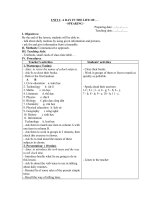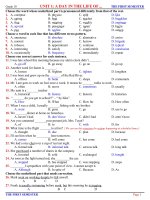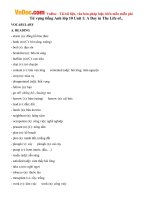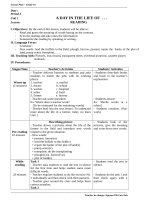Unit 1. A day in the life of...
Bạn đang xem bản rút gọn của tài liệu. Xem và tải ngay bản đầy đủ của tài liệu tại đây (145.6 KB, 12 trang )
UNIT 1: A DAY IN THE LIFE OF. . .
- SPEAKING -
Preparing date: / /
Teaching date: / /
I. Objectives:
By the end of the lesson, students will be able to:
- talk about daily routines by using given information and pictures.
- ask for and give information from a timetable.
II. Methods: Communicative approach.
III. Teaching Aids:
- Textbook, small cards of class time table. . .
IV. Procedures:
Teacher's activities Students' activities
1. Warm-up: ( 5 mins)
- Aims: to revise the names of school subjects.
- Ask Ss to close their books.
- Deliver the first handout.
A B
1. Civic education a. toán học
2. Technology b. vật lí
3. Maths c. tin học
4. Literature d. thể dục
5. Physics e. địa lí
6. Biology f. giáo dục công dân
7. Chemistry g. văn học
8. Physical education h. lịch sử
9. Geography i. công nghệ
10. History j. sinh học
11. Information
Technology k. hoá học
- Ask them to match one item in column A with
one item in column B.
- Ask them to work in groups in 2 minutes, then
check this exercise in chorus.
- Ask Ss to read aloud the names of these
subjects in chorus.
2. Presentation: ( 10 mins)
- Aims: to introduce the verb tense and the way
to tell clock time.
- Introduce briefly what Ss are going to do in
this lesson.
- Ask Ss about the verb tense to use in talking
about daily routines.
- Remind Ss of some rules of the present simple
tense.
- Recall the way of telling time.
- Close their books.
- Work in groups of three or four to match as
quickly as poSsible.
- Speak aloud their answers:
1-f ; 2-i ; 3 - a; 4 - g; 5 - b; 6 - j;
7 - k; 8 - d; 9 - e; 10 - h; 11 - c.
- Listen to the teacher
T: ( write on the board) 7. 30 ans ask a Ss to
read it aloud.
- Write some more examples and ask Ss to read
aloud.
- Ask Ss about the question :
- Ask Ss to make question for the following
sentence:
" Mai goes to school at 6. 30 a. m"
- Ask Ss to give more examples.
3. Practice: ( 20 mins)
- Aims: Ss practise speaking in pairs
+ Task 1:
- Ask Ss to open their books.
- Introduce the requirement of the task.
- Ask Ss to look at the timetable in the textbook
and read through it.
- Do the first example with a student.
T: What time does Quan have a Civic
Education leSson on Monday?
T: What leSson does Quan have at 7. 15 a. m
on Monday?
- Ask the whole class to read these sentences
again.
- Ask two pairs to read again.
- Ask Ss to work in pairs in 10 minutes to ask
and answer about Quan basing on the timetable.
- Move round to hepl Ss and to correct any
mistakes if there are.
- Ask five pairs to report because of the time
limit.
- Listen and give remarks.
+ Task 2:
- " Quan is at school in the morning, and what
does he do in the afternoon? Please look at
pictures in task 2"
- Ask Ss to work in pairs to ask and answer
about Quan's activities.
- do the first example:
T: ( look at picture 1) What does Quan do at 2.
S: seven thirty or half past seven.
S: The question begins with " What
time. . . . . . . . . . ?"
S: What time does Mai go to school?
- Open the textbook.
- Listen to the teacher.
- Look at the timetable and try to understand
it.
S: He has a Civic Education leSson at 7.
15a. m
S: At 7. 15 on Monday he has a Civic
Education leSson.
S1: What time does Quan have a Literature
leSson on Tuesday?
S2: He has a literature leSson at 8. 05 a. m
S3: What leSson dose Quan have at 10. 40 a.
m on Thursday?
S4: he has a Chemistry leSson.
S5: What time does Quan have a Physics
leSson on Wednesday?
S6: He has a Physics leSson at 9. 55 a. m
S7: What leSson does Quan have at 8. 55 on
Friday?
S8: He has an English leSson.
S9: What time does Quan have a Class
Meeting on Sarturday?
S10: He has a class meeting at 10. 40 a. m.
- look at pitures in task 2 and think of the
phrases to talk about Quan's activities. (eg:
do his wrapping, get up, etc)
S: He gets up at 2. 00 p. m
00 p. m?
- Ask Ss to work in the same way, remind Ss to
use the present simple tense with the third
person.
- Move round to control the activity and to help
Ss if necessary.
- After Ss have discussed, T can aks a student to
talk about all Quan's activities in the afternoon.
4. Futher practice: ( 8 mins)
- Aims: Ss practise speaking freely, they can
expreSs their own ideas.
+ Task 3:
- Ask Ss to think about themselves, and then
work in small groups to tell their friends about
their daily routines. - Remind Ss that they are
using the present simple with the first person.
- Move round to check the activities and to
make sure that Ss are working effectively.
- Ask one or two Ss to report in front of the
whole class.
- check and give remarks.
5. Wrapping: ( 2 mins)
- Summarise the main points
- Write a paragraph ( about 80 words) about
their daily routines in their workbook.
" At 2. 00 p. m Quan gets up, he starts to
study at 2. 15 p. m. he studies until 4. 30 and
then he watches T. V. At 5. 00 he rides to the
football yard. At 5. 15 he begins playing
football. He goes home at about 6. 30 p.
m. . . . . . . "
- Think about theit daily activities and talk to
their friends.
- Try to use English to talk.
- Listen to the teacher
UNIT 1: A DAY IN THE LIFE OF. . .
- LISTENING -
Preparing date: / /
Teaching date: / /
I. Objectives:
By the end of the lesson, Ss will be able to:
- Talk about a day in a life of a cyclo driver.
- Improve listening skill by doing pictures ordering and T-F exercises.
- Work in pairs to ask and answer about the information in the listening text.
II. Methods:
- Communicative approach
III. Teaching aids:
- Cassete tape, and textbook.
IV. Procedure:
Teacher’s activities Students’ activities
1. Wrapping checking: ( 5 mins)
Two Ss tell the whole class about their daily
routines
2. Before you listen: ( 10 mins
Aims: focus Ss on the topic and review/ introduce
the words and phrases used to describe a cyclo
driver’s daily activities.
a. T asks Ss to work in groups and make a list of
vehicles and the people who operate them, then
compare their list with other groups’
- Introduce the topic of the listening text: ‘A day
in the life of a cyclo driver’ and asks Ss to open
their books.
- Ask Ss to work in pairs to ask and answer the
questions in the textbook
Have you ever traveled by cyclo?
When was it?
Is it interesting to travel by cyclo?
Which do you prefer, going by bicycle or by
cyclo? Give reasons.
- Move around to help Ss then ask some pairs to
report.
- Give remarks.
b. VOCABULARY:
- 'passenger (n): (in the pictures) khách hàng
- 'district (n): quận, huyện
- Work in groups and recall the vehicles and
their operators then make a list on a sheet of
paper
- Compare theirs notes.
- listen to the T and open their books
- Work in pairs to ask and answer.
- Some pairs stand up and report.
S1: Have you ever traveled by cyclo?
S2: Yes, I have.
S3: When was it?
S4: Last summer holiday. . .
S5: Is it interesting to travel by cycle?
S6: Yes, it is.
S7: Which do you prefer, going by bicycle
or by cyclo?
S8: I prefer traveling by cyclo because I
have time to look around and I’m not tired.
- look at the words and read after T.
- drop (v): chở ai đó đến nơi nào đó
(when the passenger gets off the cyclo)
- 'purchases (n) = the shopping: hàng hóa (The
things someone has bought)
- food stall (n) : (In the picture) thức ăn nhanh
- Read the words aloud and asks Ss to repeat.
- Ask some Ss to read the words again.
3. While you listen: ( 20 mins)
+ Task 1:
Aims: Practise listening and ordering pictures.
- Ask Ss to work in pairs, look at the pictures in
the textbook and describe each picture.
- Do the first example:
In the first picture, a cyclo driver is cycling his
cyclo and taking a woman to somewhere.
- Introduce the situation about Mr. Lam, a cyclo
driver in Hochiminh city talking about his daily
routines. T asks Ss to listen to the tape/ teacher
and number the pictures in the correct order.
- play the tape/ read the text twice.
- Ask Ss to share their answers in pairs.
- Get Ss’ answers.
- play the tape once again, stop where necessary
and conduct the correction.
+ Task 2:
Aims: Practice listening for specific information
by deciding if the given statements are true or
false.
- ask Ss to have a look at the statements and read
them in pairs and make sure they understand the
statements.
-Ask Ss to listen to the tape/T again and tick the
box to indicate if the statements are true or false.
- Ask Ss to compare their answer in pairs.
- Checks Ss’ answers.
- Play the tape once again, stop where necessary
and conduct the correction.
4. After you listen: ( 8 mins)
- Ask Ss to work in pairs and use the suggested
words to ask and answer about the cyclo driver.
- Move round to check the activities and to make
- copy the words and phrases.
- listen and repeat.
- Some individuals read the words aloud
- look at the pictures and listen to the T.
- describe the other pictures in pairs.
- listen to the teacher.
- listen to the tape / the teacher and do the
task
- Share their answers.
- give feedback.
- check their answers, and then correct their
work if they have any wrong answers.
Key: 5 – 6 – 1 – 3 – 2 – 4
- Read the statements, underline the key
words in each sentence.
- Try to gueSs whether each sentence is true
or false.
- Listen and do the task.
- Share their answers with their partners.
- Give answers.
- Listen again and check.
Key: 1F; 2T; 3F; 4F; 5F.
sure that Ss are working effectively.
- Ask one or two Ss to retell the cyclo driver’s
routines in front of the whole class.
- Check and give remarks.
5. Wrapping: (2 mins)
- Summarise the main points
- Write a short paragraph about Mr. Lam's
routines
- Work in pairs to ask and answer questions
such as:
" What is the man's name?"
" What does he do?"
. . . . . . . . . . . . .
UNIT 1: A DAY IN THE LIFE OF. . .
LESSON 3: WRITING
Preparing date: / /
Teaching date: / /
I. Objectives:
By the end of the lesson, Ss will be able to:
- Find out the verbs in the past simple and the connectors.
- Write a narrative using the given prompt
- discuss in groups to share their answers.
II. Methods:
- Communicative approach
III. Teaching aids:
- picture and textbook.
IV. Procedures:
Teacher's activities Students' activities
1. Warm- up: ( 10 mins)
GAME: Noughts and Crosses
- Draw a table containing 9 words in each cell.
- Devide the class into two groups: Noughts (0)
and Crosses (x)
- Ask ss to choose word by word in each cell and
make sentences with each word. A correct answer
gets one (0) or (x). The group with 3 (0) or (x)
vertically, horizontally or even diagonally first
will be the winner.
At first Before Until
Then After As soon as
In the end While Since then
2. Before you write: ( 15 mins)
- Aims: to provide Ss with the materials
( vocabulary, grammar, form) to write.
- Ask them to read through the passage in two
minutes to get the main idea.
- Ask one student to report.
- Explain some new words/ phrases in the passage:
+ stare death in the face: đối mặt với tử thần
( \explain the meaning of each word, then let Ss
guess the meaning of the whole phrase)
+ 'fasten seat belt (v):
+ dip (v) : move to a lower level.
- Ask Ss to listen and read these words again.
- Ask them to read the passage again more
carefully and do task 1 in 5 minutes.
- Move round to make sure that all Ss are working.
- Listen to the teacher
- Choose the number and make sentence with
the word in the table
- Look at Task 1.
- Read through the passage individually.
- S: The most frightening experience of the
writer's life when he (she) travelled on a plane
on 14th July 1995.
- Listen and repeat:
+ stare death in the face
+ fasten
+ dip
- Read the passage again and do task 1.
+ Verbs used in the past simple: stared, was,
arrived, got, took off, began, thought, were
told, seemed, realised, were, screamed,
- Ask them to share their answers with their
partners.
- Check the task by asking two Ss to report.
- Give remarks.
- Ask Ss to read the passage again and in groups to
do task 2.
- Divide the class into three regions: one identifies
the events, one identifies the climax and the rest
identifies the conclusion.
- Ask Ss to work in only 2 minutes.
- Ask three representatives of three groups to
report.
- Draw the conclusion about writing a narrative.
+ Form: 3 parts: - introduction.
- body: events, climax
- conclusion
+ Verb tense: the past simple tense.
+ Connectors: at that time, on that day, then, after
that, a few minutes later, until, etc.
3. While you write: ( 10 mins)
- Aims: students practise cotrolled- writing.
+ Task 3:
- Explain how to do the task
- Ask Ss to build up a narrative about a hotel fire
using the prompts and follow the development of
writing sample in task 1.
- Ask them to work individually.
- Move round to conduct the activity and to note
down Ss' mistakes.
- Ask Ss to share their answers with their partners.
4. After you write: (8 mins)
-Aims: to get feedback.
- Ask Ss to report their work sentence by sentence.
- Remind Ss that they should use the past simple
to write.
- Give comments and correct typical mistake
5. Wrapping( 2mins)
- Summarise the main points
- Assign the homework by asking ss to complete
thought, had, felt, gained, announced, landed.
+ Connectors ( expressions of time): on that
day, at first, then, a few minutes later.
- Work in groups.
- Report the answers:
+ The events: people got on plane, plane took
off, hostesses were just beginning to serve
lunch when plane began to shake, plane
seemed to dip, people screamed in panic.
+ The climax: We thought we had only minutes
to live.
+ The conclusion: the pilot that everything was
all right, we landed safely; it was the most
frightening experience of my life.
- Listen to the teacher
- Write the passage into their notebooks.
Last year I spent my summer holidays at a
seaside town. The hotel was modern and
comfortable. I had a wonderful holiday until
the fire.
It was Saturday evening and everyone was
sitting in the discothequeon the ground floor.
It was crowded with people. They were
dancing and singing happily. Suddenly we
smelt smoke. Then black smoke began to fill
the room. Everybody started to scream in
panic. People ran away toward the fire exits.
One door was blocked. Many people began to
cough and to choke.
Then just as we thought we had only minutes to
live, the fire brigade arrived. Firemen fought
their way into the room and soon everyone was
safely out of the building. Luckily, nobody was
seriously hurt. It was the most frightening
experience of my life.
the writing and prepare the new lesson. - Listen to the teacher
UNIT 1: A DAY IN THE LIFE OF. . .
-LANGUAGE FOCUS-
Preparing date: / /
Teaching date: / /
I. Objectives:
By the end of the lesson, Ss will be able to:
- Distinguish the sound / I / from the sound /i: / and pronounce them correctly.
- Use the present simple tense, the past simple tense and adverbs of frequency correctly.
II. Methods:
- Communicate approach
III. Anticipated problems:
- Students may have difficulty in pronounce /I / and /i: / correctly so T must explain
carefully the difference between two sounds.
IV. Teaching aids:
- Pictures and textbook.
V. Procedures:
Teacher's activities Students' activities
1. Wrapping checking. ( 7 mins)
- Warm-up: (5 minutes)
- Ask students to keep book close
- Give the picture that has a sheep on the ship
- Ask students to complete the sentence:
I see a … on the …
- Ask students to speak the sentence loudly
- Let students to get their attention on
pronunciation: /I/- /i: /
- Introduce new lesson
2. Pronunciation: ( 8 mins)
- Aims: to introduce the two sounds and to
help Ss to read these sounds correctly.
- Introduce two sounds / I / and /i: /.
- Read each sound twice and then ask Ss to
listen and repeat.
- Ask Ss to look at the book, then listen and
repeat.
- Ask Ss to practise reading these words in
groups.
- Ask some Ss to read aloud and give
remarks.
- Ask Ss to look at part 2 and tell Ss what they
are going to do.
- Do the first example: ( read the sentence
aloud and underline the sounds)
1. Is he coming to the cinema?
- Keep book close
- Listen to the teacher
- Look at the picture and complete the
sentence:
I see a sheep on a ship.
- Look at the board.
- Listen to the teacher and then listen and
repeat / / and /i: /
- Listen and repeat.
/ɪ/ / i: /
hit kick heat repeat
bit click beat read
little interested meat eaten
/ɪ/ /ɪ/ /ɪ/ /ɪ/
- Ask Ss to work in pairs to practise reading
and to find the sounds in the rest sentences.
- Remind them of the intonation of the
questions.
- move round to help if necessary.
- Ask some Ss to read these sentences aloud.
- Give remarks.
3. Grammar: ( 30 mins)
- Aims: to revise the present simple tense and
the past simple tense.
- Ask Ss to think about the present simple
tense and ask some to tell the whole class
about the form and the use of the tense.
- Ask Ss about the position of adverbs of
frequency.
- Ask Ss to do Ex 1 individually in 5 minutes,
then share their answers with their partners.
- Explain any new words if necessary.
- Ask some Ss to report and give remarks.
- Ask Ss to do Ex 2 orally in pairs in 2
minutes.
- Move round to conduct the activity.
- Ask 2 Ss to report.
- Present the past simple tense.
- Ask some students to tell the whole class
about the form and the use of this tense.
- Ask Ss to look at Ex 3 and explain what Ss
are going to do.
- Ask Ss to do this exercise in 5 minutes, then
share their answers with their partners.
- Ask them to pay attention to the past form of
irregular verbs and some verbs are put in
paSsive voice.
- Ask 2 Ss to do this exercise on the board.
- Move round to help Ss if necessary.
- Check and give remarks.
4. Wrapping ( 2 min)
- Summarise the main points
- Ask ss prepare the new lesson: Unit 2
2. We'll miss the begining of the film.
3. Is it an interesting film, Jim?
( sound /ɪ/)
4. The beans and the meat were quite cheap.
5. He's going to leave here for the Green
Mountains.
6. Would you like to have meat, peas and
cheese?
(Sound / i: /)
+ Form: (+) S + V/ Vs/ Ves +. . . . . . .
(- ) S + don't/ doesn't + V +. . . . . .
(?) Do/ Does + S + V +. . . . . . . . . . ?
+ Use: to talk about present habits or present
states.
+ Position:
- After "to be" but before other verbs.
- "As a rule" is placed at the beginning of a
sentence.
1. is 7. catch
2. fish 8. go
3. worry 9. give up
4. are 10. say
5. catch 11. realise
6. am 12. am
Sample answers:
He always get up early.
She is sometimes late for school.
Lan normally practises speaking English.
As a rule, Thao is a hard- working student.
+ Form: (+) S + V-ed/ V( irregular) +. . . . . . . .
( - ) S + didn't + V +. . . . . . . . . .
( ? ) Did + S + V +. . . . . . . . . . . . . ?
+ Use: to indicate that somthing happen in the
past.
1. was done 7. began 13. was
2. cooked 8. felt 14. leapt
3. were 9 put out 15. hurried
4. smelt 10. crept 16. found
5. told 11. slept 17. wound
6. sang 12. woke 18. flowed









